

MCR – How Smart Is My City? Free tickets available at Eventbrite!

Thursday, 15th January 2015, 6.30pm at The Shed, Digital Innovation, John Dalton West, Manchester Metropolitan University, Chester Street, Manchester M1 5GD How smart is your city? We are a city species. We are drawn to cities to live, work and play. Some of us do this out of conscious choice – to be amongst others, to experience the vitality and serendipity – others do it out of economic necessity and security. From the early cities on the Mesopotamian plain the city has evolved to be a focus of trade, power and security. Cities offer resource and production efficiencies due to density and agglomeration, but even these efficiencies are reaching their limit.
Can these challenges be fixed through technology? EIP - Smart Cities and Communities Market Place. Urbanscale. Over the past ten years, dozens of cities around the world have installed expensive, nominally “interactive” informational kiosks in their sidewalks, plazas and public places.
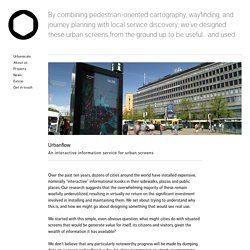
Our research suggests that the overwhelming majority of these remain woefully underutilized, resulting in virtually no return on the significant investment involved in installing and maintaining them. We set about trying to understand why this is, and how we might go about designing something that would see real use. We started with this simple, even obvious question: what might cities do with situated screens that would be generate value for itself, its citizens and visitors, given the wealth of information it has available?
We don’t believe that any particularly noteworthy progress will be made by dumping data on a screen and calling it a day, let alone transposing an utterly inappropriate “app” model from smartphones to large, situated displays. Journey planning and wayfinding/wayshowing. Gallery · mbostock/d3 Wiki. Wiki ▸ Gallery Welcome to the D3 gallery!

More examples are available for forking on Observable; see D3’s profile and the visualization collection. Please share your work on Observable, or tweet us a link! Visual Index Basic Charts Techniques, Interaction & Animation Maps Statistics Examples Collections The New York Times visualizations Jerome Cukier. Design and publish beautiful maps. Leaflet - a JavaScript library for mobile-friendly maps. Smart Citizen : Smartcitizen. What are the real levels of air pollution around your home or business?
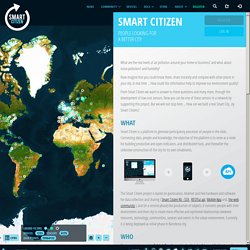
And what about noise pollution? And humidity? Now imagine that you could know them, share instantly and compare with other places in your city, in real time ... How could this information help to improve our environment quality? From Smart Citizen we want to answer to these questions and many more, through the development of low-cost sensors.
What. Smart Citizen : Devices. Smart Citizen : Smart Citizen : Citizen Science Platform for participatory processes of the people in the cities. Connected Smart Cities Conference » FIWARE. Open Smart Cities I: Open Source Internet of Things - Open Smart Cities I: Open Source Internet of Th... "Open Smart Cities I" is the first post of a series of three that address, from the point of view of open source software, several technological areas related to Smart Cities, as the Internet of Things, Cloud, Big Data, or Smart Cities platform of services and applications.
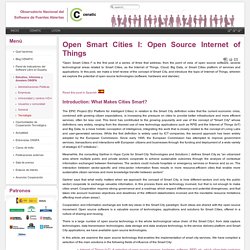
In this post, we make a brief review of the concept of Smart City, and introduce the topic of Internet of Things, wherein we explore the potential of open source technologies (software, hardware and standar). Read this post in Spanish Introduction: What Makes Cities Smart? The EPIC Project (EU Platform for Intelligent Cities) in relation to the Smart City definition notes that the current economic crisis, combined with growing citizen expectations, is increasing the pressure on cities to provide better infrastructure and more efficient services, often for less cost.
Cooperation and information exchange are both key ideas in the Smart City paradigm. 2. 2.1. More information: 2.2 Arduino. Open Smart Cities I: Open Source Internet of Things - Open Smart Cities I: Open Source Internet of Th... Thales VivaCity: Solutions for the Smart City. Vicente Guallart - Barcelona 5 0. Smart Cities and Urban Analytics. The UCL Bartlett Centre for Advanced Spatial Analysis (CASA) is one of the leading research centres in the science of cities, generating new knowledge and insights for use in city planning, policy and design, and drawing on the latest geospatial methods and ideas in computer-based visualisation and modelling.

Smart Cities is a key area of future innovation and investment in the UK, and Smart Cities and Urban Analytics is currently the only UK-based Master’s programme available. Companies such as Intel, IBM, ARUP and CISCO all have strategies around Smart City development, creating a demand for skilled personnel. CASA has been in talks with all of these companies and the Programme Director sits on the newly-created Smart Cities Board at the Greater London Authority to advise the Mayor on developments.
Student / staff ratios › 8 staff › 19 taught students › 14 research students Department: Centre for Advanced Spatial Analysis. Are better signs the secret to a successful city? Street signs, airport signs, signs in shopping malls and railway stations: they’re all around us, but we only really notice them when they go wrong – when we’re looking for a sign that’s not there, or are led in a circle by a mysterious set of signs whose promised objective never appears, as though we are the butt of some deadpan semiotic joke cooked up in the bowels of the University of Paris.
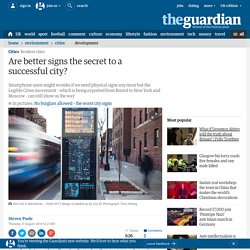
Yet signs are, of course, carefully designed objects. They have a history and, right now, are even in the throes of something like a revolution. The Legible Cities movement takes its inspiration from the American social geographer Kevin A Lynch, who published the seminal book The Image of the City in 1960, introducing the concept of the “legibility” of urban space. The modern Legible Cities idea began in Bristol in the late 1990s, when planners wanted to communicate information about city-centre regeneration projects. But would we want to? Seizing Our Destiny. The Sunday breakfast review - 'Seizing Our Destiny', published by ICF Market analysts, by definition, take a very sectorised view of the way economies function.
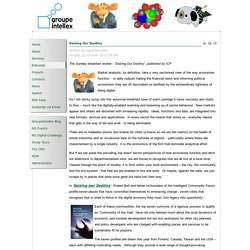
In daily outputs fueling the financial news and informing political economists they are oft fascinated (or terrified) by the extraordinary lightness of being digital. As I stir sticky syrup into this autumnal breakfast bowl of warm porridge it loses viscosity and starts to flow – much like the digitally-enabled warming and loosening up of sector behaviour. New markets appear and others are absorbed with increasing rapidity. New Europe - Cities in Transition. Smart Cities. Www.smart-circle.org/smartcity/wp-content/uploads/sites/3/2014/05/Table-17-Eurbanlab.pdf.